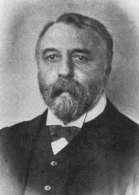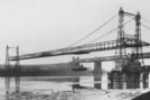
LINKS UNTEN
Website
über
die
Schwebefähre
von
Widnes-Runcom
Website
der
Gemeinde
Halton
mit
Geschichte
der
Schwebefähre
![]()
Cn 1905 terminan las obras del transbordador de
Widnes, con el mayor travesano de todos los que se construyeron en el mundo,
305 metros. Las torres tienen una altura de 58 metros. Su coste tue de
130.000 libras, inaugurado el 29 de mayo de 1905, realizando este primer
día un total de 39 viajes, que supuso transportar más de
13.000 personas. El 22 de junio de 1961 realizó su última
singladura, siendo sustituido por otro de carretera.
![]()
In 1905 the bridge at Widnes was finished, having
the largest upper span of all those that had been built, 305 metres. The
towers were 58 metres high. Its cost was 130,000 pounds. It was inaugurated
on 29th May, 1905, carrying out 39 trips which meant transporting more
than 13,000 people. On 22nd June, 1961, it made its last trip, being substituted
by a road bridge.
Alfredo Pérez Trimino: "Puente Vizcaya - mi vida en imágines", Bilbao, 2000.
Nur
ein paar Bilder
im
Pub sind geblieben
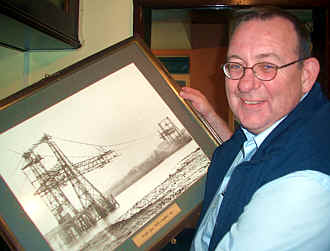
Abgerissen: die Schwebefähre im Chemie-Revier
Die Fähre mußte einer neuen Brücke weichen
Die Transporter Bridge über den Mersey zwischen Widnes und Runcorn war 1905 eröffnet worden. Sie sollte die überlastete Flussfähre über den schmutzigen Fluß im Chemierevier ablösen.
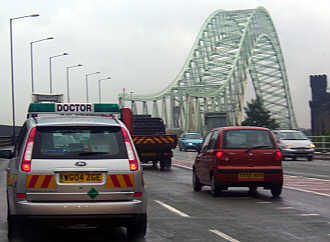
1961 eröffnet: Straßenbrücke Widnes - Runcorn
Im Jahre 1961 wurde die Schwebefähre durch eine Straßenbrücke ersetzt - und umgehend abgerissen.
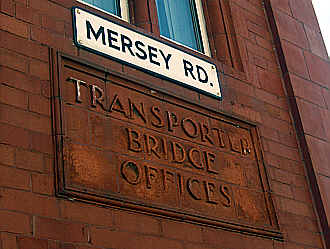
Das frühere Verwaltungsgebäude
Heute erinnern nur noch wenige Relikte an die Schwebefähre.
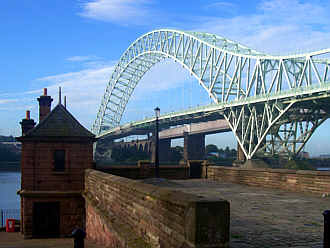
Die Fährrampe neben der neuen Brücke
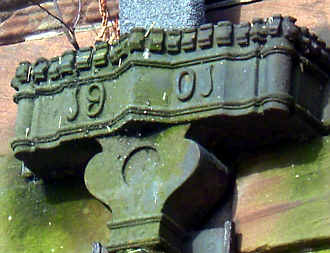
Architektonisches Detail am Nebengebäude
In Widnes ist am Ende der Mersey Road die Fähr-Rampe samt einem Nebengebäude aus dem Jahr 1901 erhalten, ebenso das Haus der früheren Fährverwaltung.
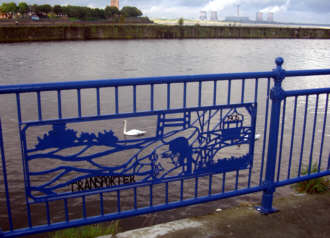
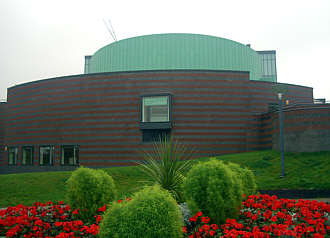
Das neue Kulturzentrum in Runcorn
Gut ein halbes Jahrhundert nach der Verschrottung der Schwebefähre ist das Bauwerk zum Objekt nostalgischer Erinnerung geworden; manch einer bedauert die Freveltat von 1961.
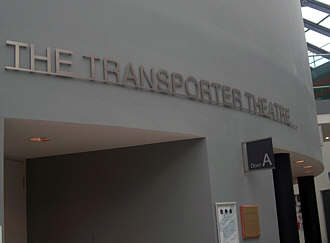
Nach der Schwebefähre benannt: das Theater
Als nach dem Bau eines neuen Kulturzentrums per Bürgerbefragung ein Name für den Theatersaal gesucht wurde, sprache sich eine Mehrheit für "The Transporter Theatre" aus.
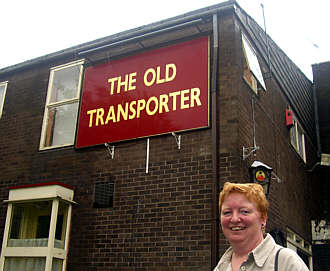
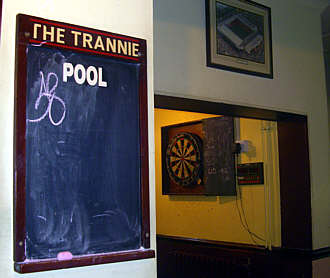

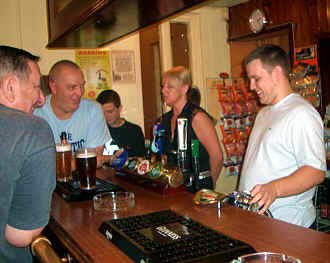
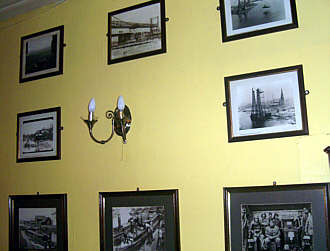
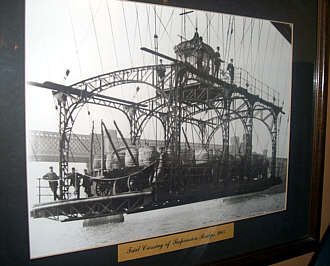
Verschrottet: die Gondel der einstigen Fähre
![]()
"A
magnificient feat of
Edwardian
engineering"
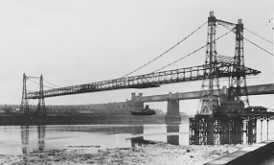
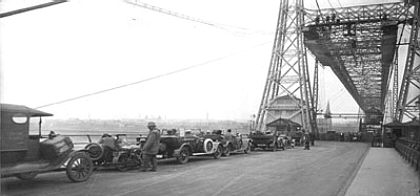
At the time, the expense and engineering complexity of a high-level road bridge were prohibitive, although a high-level railway bridge had been constructed some years earlier (1868). The total cost of the Transporter Bridge was £130,000, about one third of the cost of a high-level bridge.
Mehr historische Fotos hier
The bridge was a magnificent feat of Edwardian engineering. The span of the bridge across the Mersey was 1000ft [305m]. The bridge towers stood 190ft [58m] above high water, and the main cables supporting the bridge were 12in [300mm] thick. However, the suspended car was very sensitive to adverse weather, and would often be closed down in high winds.
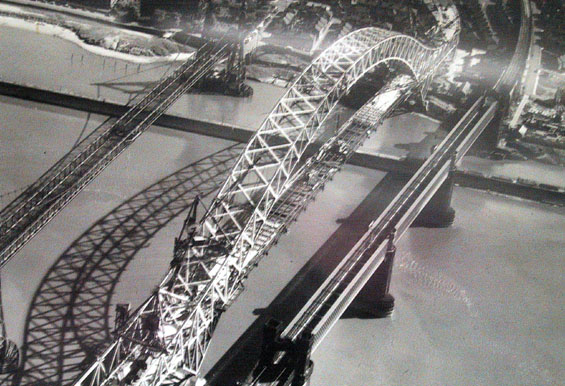
Aerial view of the three bridges over the Mersey before
the Old Transporter Bridge on the left was demolished
Widnes Corporation had a controlling interest in the bridge, and as the operators of the bus department, arranged a fairly integrated transport service, with a Corporation bus stop only yards away from the bridge ticket office. The bus service on the Runcorn side was privately operated, and not so well integrated: the nearest bus stop was about a mile from the bridge.
The most prestigious passengers on the bridge were King George V, in 1925, and Queen Elizabeth, the Queen Mother, who visited the site in 1958. The domes on top of the towers were especially painted for the latter occasion, even though it was known that the bridge had only three years of remaining life.
A high-level road bridge was finally built. It was opened by Princess Alexandra on 21 July 1961, and the Transporter Bridge was closed the very next day.
It was scheduled for demolition almost immediately.
![]()
Road traffic could not cross the River Mersey
at Runcorn until a transporter bridge was opened in 1905. It was the second
bridge to be built across the River Mersey at this point. The Widnes
& Runcorn Bridge Company was formed in 1899 to get this
bridge built and work started on the bridge, designed by Warrington-born
engineer John Webster in December 1901.
The total cost of the bridge was £137,663 6s 4d (the cost today would
be about £8 million).
It was a popular attraction and over 2000 people an hour were carried on its opening day. The transporter bridge moved vehicles and people from one side of the river to the other by using a large transporter car which was pulled by cable. The transporter car took two and a half minutes to cross the river and could carry twelve vehicles and 300 passengers.
The bridge was opened by Sir John Brunner, chairman of the Widnes & Runcorn Bridge Company, on 19 May 1905. The bridge had earlier been tested for strength when seven horses and five wagons of the mineral silicate weighing 36 tons were placed on it. The ownership of the bridge was transferred to Widnes Corporation in 1911 and the bridge was temporarily closed for an upgrade before re-opening on 21 May 1913.
In the late 1940s the transporter bridge needed further improvements and the increase in road traffic made things worse. By 1958 there were two million passengers, 150,000 private vehicles and 100,000 commercial (business) vehicles per year. The bridge was often closed in bad weather because the transporter car couldn't dock. Another problem was that the last car crossed the river at 11.30 p.m. so those wanting to cross the river late at night often had to either walk over the rail bridge footway or take a road detour via Warrington.
The last
journey over
the transporter
bridge
The last fare-paying trip on the transporter bridge was made at 6 p.m. on 21 July 1961 and it officially closed the following morning when 250 specially invited guests made the last trip. The car was painted silver for the day and despite flags flying, hooting tugboats, a band, and ringing church bells, only a handful of people took any notice as they were more interested in the new road bridge which had been built alongside.
The transporter bridge was demolished at a cost of £139,602 - £2000 more than it cost to build (it would have cost almost £2 million to demolish today).
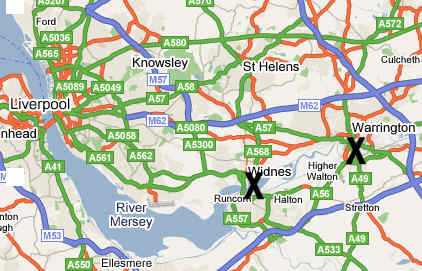
Standorte der Schwebefähren über den Mersey
in its day
![]()
On July 22nd, 1961, the famous Runcorn-Widnes
Transporter Bridge closed, to bring to an end a feat of engineering that
had been a marvel in its day.
For over fifty years the Transporter had spanned 1,000 feet across the Mersey estuary and the Manchester Ship Canal.
Designed by J. J. Webster, of London, it cost £130,000 and was officially opened on May 29th, 1905, by the Liberal MP and chemical magnate, Sir John Brunner.
The need for some sort of bridge had been urgently needed for years, to supplement the first up-river crossing point at Warrington. Previously, and surprising as this may seem now, the estuary had also been forded at Hale and there had been a ferry linking Runcorn and Widnes since the 11th century.
By the end of the 19th century Runcorn had become a place of some importance as the terminus of the Bridgewater Canal, while Widnes had developed into a centre for heavy chemical manufacturing.
The Transporter was a spectacular enterprise and came about from 1899, following the passing of an Act of Parliament and the formation of a company to build and operate the bridge.
The total share capital was £100,000 of which sum the Widnes Corporation was responsible for £25,000 and the Runcorn Urban Council £10,000.
In spite of eleven petitions against the project, from various authorities and persons in Widnes and Runcorn, the Bill received royal assent on 10th July, 1900 and work duly commenced on what was to be then the largest span of any bridge in the United Kingdom for carrying road traffic.
The Conway Bridge had a span of 327ft, the Menai Suspension Bridge of 570ft and the Clifton Suspension Bridge 702ft.
The Widnes Foundry Company constructed the approach girders, the towers and the cylinder foundations which were braced together and bolted to solid rock. The Transporter itself had a platform 55ft long and 24ft wide, suspended by steel wire ropes under the bridge trolley.
Vehicles drove onto this small platform and the whole contraption was moved by electricity across the 1,000ft span. The transporter ran approximately every twenty minutes and could move some thirty-six vehicles an hour in each direction. The crossing took about four minutes.
By the time of its closure, and replacement by the modern Runcorn-Widnes Bridge, in 1961, the Transporter was estimated to have carried over one million foot passengers and a quarter of a million vehicles each year.
Cheshire Magazine
-
